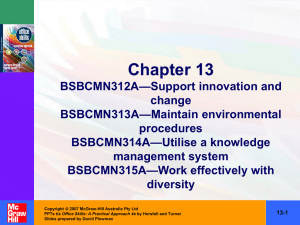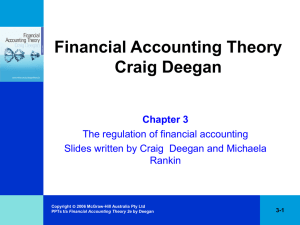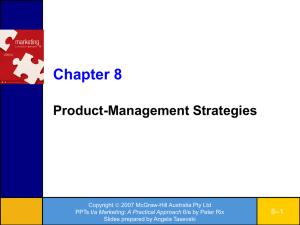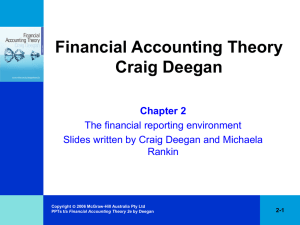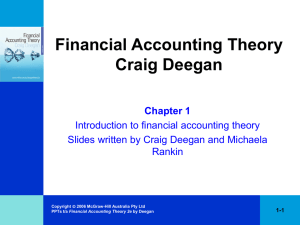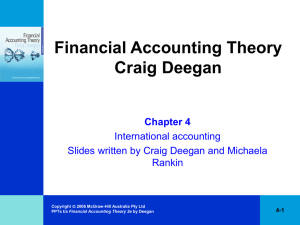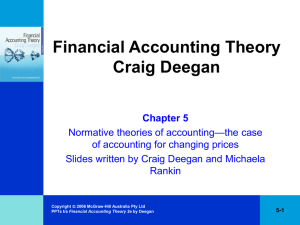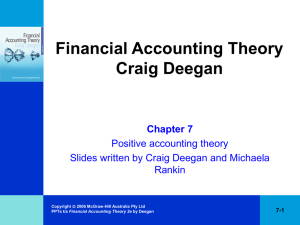Global strategy
advertisement
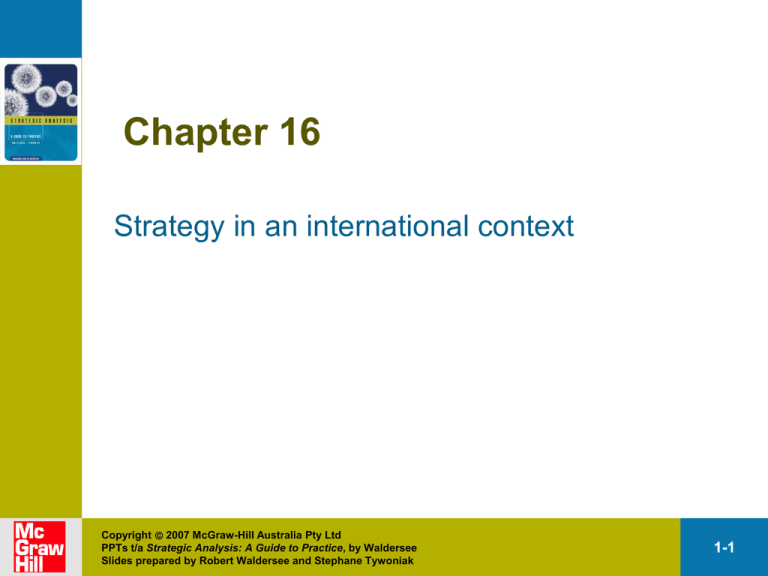
Chapter 16 Strategy in an international context Copyright 2007 McGraw-Hill Australia Pty Ltd PPTs t/a Strategic Analysis: A Guide to Practice, by Waldersee Slides prepared by Robert Waldersee and Stephane Tywoniak 1-1 Traditional approach to internationalisation Ricardo’s theory of internationalisation Similar to the RBV, nations have natural advantages (e.g. oil) Adapted from Vernon (1966) With this advantage and dominance, foreign expansion is successful This permits local firms to dominate in industries where there is advantage Copyright 2007 McGraw-Hill Australia Pty Ltd PPTs t/a Strategic Analysis: A Guide to Practice, by Waldersee Slides prepared by Robert Waldersee and Stephane Tywoniak 1-2 Traditional theory of internationalisation and free trade • For the traditional model to operate, free trade is required. • Trade barriers negate the comparative advantage of other countries and allow nations to inefficiently produce where they have no comparative advantage. Copyright 2007 McGraw-Hill Australia Pty Ltd PPTs t/a Strategic Analysis: A Guide to Practice, by Waldersee Slides prepared by Robert Waldersee and Stephane Tywoniak 1-3 16.2 Chiquita Bananas • Chiquita came to dominate the banana industry (prior to WWI) using the US comparative advantages of transportation and disease control. • Those advantages are now diluted and Central America now has the comparative advantage with labour costs, land and climate. • Why does Chiquita still dominate the banana industry? Copyright 2007 McGraw-Hill Australia Pty Ltd PPTs t/a Strategic Analysis: A Guide to Practice, by Waldersee Slides prepared by Robert Waldersee and Stephane Tywoniak 1-4 16.2 Chiquita Bananas • Resources: • Capabilities Copyright 2007 McGraw-Hill Australia Pty Ltd PPTs t/a Strategic Analysis: A Guide to Practice, by Waldersee Slides prepared by Robert Waldersee and Stephane Tywoniak 1-5 International strategies follow two vectors: high global strategy transnational strategy export strategy multi domestic strategy low high need to reduce costs low need for local adaptation Copyright 2007 McGraw-Hill Australia Pty Ltd PPTs t/a Strategic Analysis: A Guide to Practice, by Waldersee Slides prepared by Robert Waldersee and Stephane Tywoniak 1-6 Export strategy • Rationale: leverage home-based core competencies in foreign markets. Multi domestic strategy • Rationale: favour adaptation to local markets through decentralization at country-level Global strategy • Rationale: standardizing products and services to maximize scale and location economies Transnational strategy • Rationale: attempt to capture the ‘best of both worlds’ through scale and location economies and adaptation. Leveraging innovation and learning throughout the organization Copyright 2007 McGraw-Hill Australia Pty Ltd PPTs t/a Strategic Analysis: A Guide to Practice, by Waldersee Slides prepared by Robert Waldersee and Stephane Tywoniak 1-7 16.6 WineRidge’s international strategy high global strategy transnational strategy export strategy multi domestic strategy low high need to reduce costs low need for local adaptation Position WineRidge and justify answer Copyright 2007 McGraw-Hill Australia Pty Ltd PPTs t/a Strategic Analysis: A Guide to Practice, by Waldersee Slides prepared by Robert Waldersee and Stephane Tywoniak 1-8 16.6 WineRidge’s international strategy high need to reduce costs low global strategy International distribution export strategy Australian winemaking low transnational strategy multi domestic strategy US JV high need for local adaptation Copyright 2007 McGraw-Hill Australia Pty Ltd PPTs t/a Strategic Analysis: A Guide to Practice, by Waldersee Slides prepared by Robert Waldersee and Stephane Tywoniak 1-9 The rule of dinosaurs: mature industry structure and problems with the traditional model Large Chiquita Bananas Firm number Small Small Firm size Copyright 2007 McGraw-Hill Australia Pty Ltd PPTs t/a Strategic Analysis: A Guide to Practice, by Waldersee Slides prepared by Robert Waldersee and Stephane Tywoniak Large 1-10 Comparative advantage, internationalisation and free trade Free trade provided great benefit for large firms. The resources and capabilities that mattered were experience, scale, distribution and capital rather than capabilities based on domestic comparative advantage. Copyright 2007 McGraw-Hill Australia Pty Ltd PPTs t/a Strategic Analysis: A Guide to Practice, by Waldersee Slides prepared by Robert Waldersee and Stephane Tywoniak 1-11 A theory for large firms, mature industries and developed economies. Free trade + Size, experience, capital etc. = Options of: 1. Export 2. Multi domestic 3. Global 4. Transnational The traditional model does not explain the internationalisation of firms in small or developing economies. Copyright 2007 McGraw-Hill Australia Pty Ltd PPTs t/a Strategic Analysis: A Guide to Practice, by Waldersee Slides prepared by Robert Waldersee and Stephane Tywoniak 1-12 The strategies of firms in smaller or developing nations high industry pressure to internationalise low dodger strategy contender strategy defender strategy extender strategy customised to home market transferable abroad resources and capabilities Copyright 2007 McGraw-Hill Australia Pty Ltd PPTs t/a Strategic Analysis: A Guide to Practice, by Waldersee Slides prepared by Robert Waldersee and Stephane Tywoniak 1-13 Dodger strategy • Avoid competing directly with multinationals: – collaborate through JVs, become a supplier, sell out Contender strategy • Aims to accelerate growth and compete on equal terms with foreign giants through: – cooperation with top suppliers and customers – foreign acquisitions Defender strategy • identifies a niche market where it can serve the local customer better than the multinationals. Extender strategy • Use a strong base in the home market to expand in similar markets abroad (selective internationalization). Copyright 2007 McGraw-Hill Australia Pty Ltd PPTs t/a Strategic Analysis: A Guide to Practice, by Waldersee Slides prepared by Robert Waldersee and Stephane Tywoniak 1-14 16.14 The Embraer case high need to reduce costs low global strategy transnational strategy export strategy multi domestic strategy high low need for local adaptation high dodger strategy contender strategy industry pressure to extender interdefender strategy nationalise strategy low transferable customised to abroad home market resources and capabilities Where does Embraer fit within each model Copyright 2007 McGraw-Hill Australia Pty Ltd PPTs t/a Strategic Analysis: A Guide to Practice, by Waldersee Slides prepared by Robert Waldersee and Stephane Tywoniak 1-15 16.14 The Embraer case high need to reduce costs low global strategy transnational strategy export strategy multi domestic strategy high low need for local adaptation high dodger strategy contender strategy industry pressure to extender interdefender strategy nationalise strategy low transferable customised to abroad home market resources and capabilities Where does Embraer fit within each model Copyright 2007 McGraw-Hill Australia Pty Ltd PPTs t/a Strategic Analysis: A Guide to Practice, by Waldersee Slides prepared by Robert Waldersee and Stephane Tywoniak 1-16 Smaller economy internationalisation • Tendency to succeed in niche areas or new industries. • Tendency to become global very quickly without dominating the domestic market. • Known as “born global” firms. Copyright 2007 McGraw-Hill Australia Pty Ltd PPTs t/a Strategic Analysis: A Guide to Practice, by Waldersee Slides prepared by Robert Waldersee and Stephane Tywoniak 1-17 16.16 Incat’s global strategy Use industry maturity to explain why Incat is so successful whereas naval contracts have led to very modest exports Copyright 2007 McGraw-Hill Australia Pty Ltd PPTs t/a Strategic Analysis: A Guide to Practice, by Waldersee Slides prepared by Robert Waldersee and Stephane Tywoniak 1-18 16.16 Incat’s global strategy Aluminium, wave piercing, high-speed large craft is effectively a new industry. There are no giants in this industry Copyright 2007 McGraw-Hill Australia Pty Ltd PPTs t/a Strategic Analysis: A Guide to Practice, by Waldersee Slides prepared by Robert Waldersee and Stephane Tywoniak Traditional ship-building is a consolidated, mature industry dominated by a few giants 1-19 Everything old is new again? Many of today’s giants in mature industries started as ‘born globals, for example: • Microsoft • Nestle Today’s ‘born globals’ may be tomorrow’s dinosaurs. Copyright 2007 McGraw-Hill Australia Pty Ltd PPTs t/a Strategic Analysis: A Guide to Practice, by Waldersee Slides prepared by Robert Waldersee and Stephane Tywoniak 1-20


